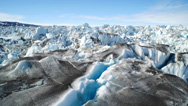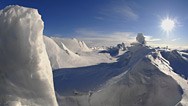Sea Level Rise: When 1 in = 2 ft
- By Ari Daniel
- Posted 10.22.15
- NOVA
As the ice caps melt and dump more water into the ocean, global sea level will rise. But the amount of that increase depends on where you are on the planet. And the result will be less land in the future than there is now.
Transcript
Ari: The ocean’s rising a few millimeters each year right now. That you may know, but it turns out that sea level isn’t rising equally everywhere. Here are four reasons why.
First, weather. In particular, fierce storms and hurricanes will be spinning up in different places on the planet.
Fiamma: These storms have a major impact on regional sea level extremes.
Ari: So it’s not just the gradual rise of global sea level.
Fiamma: You have these large storms that give you your flood times on top of it. And so if you change the storms—if they become more intense, if you increase their frequency—these extremes in flooding will have a larger impact.
Ari: Second, the ocean has a natural tilt.
Fiamma: There’s a drop in height while you’re crossing the Gulf Stream. It’s over a long distance – you’re not gonna fall off a cliff as you cross the Gulf Stream, but it’s on the order of several feet.
Ari: It’s the Gulf Stream itself that causes the tilt. Faster currents mean more tilt. Slower currents mean less tilt. And if you melt ice in the ocean and add more freshwater, this could impact the strength of the Gulf Stream and the angle of that tilt.
Fiamma: So you can get changes in sea level locally just by redistributing this water.
Ari: Third, as ocean water gets warmer due to climate change, that water is going to expand.
Fiamma: You don’t need to add mass for this to happen—if you just warm the water, you’ll expand it.
Ari: And because the whole ocean won’t warm by the same amount, sea level will rise differently depending on where you are on the planet.
And finally, there’s gravity. The more mass something has, the greater the gravitational force it exerts. Right now, the ice caps at the poles are massive, which means they pull ocean water towards the Antarctic and the Arctic.
Fiamma: Once you start melting ice either in Antarctica or in Greenland, you are reducing the gravitational attraction that these ice sheets exert on the ocean. This means that sea level will drop close to Greenland, the same for Antarctica. But now this water has to go somewhere – so it will rise in the tropical regions, in the equatorial regions.
Ari: We still don’t know how all these forces will play out. But one thing is clear—some areas will take a harder hit than others.
Fiamma: Hit!
Credits
PRODUCTION CREDITS
- Videography, Production, and Narration
- Ari Daniel
- Visualization Assistance
- Ceri Riley
- This research was funded by:
- the National Science Foundation
- Financial support for reporting provided by:
- the Pulitzer Center on Crisis Reporting
- Original Footage
- © WGBH Educational Foundation 2015
MEDIA CREDITS
- Additional Visuals
- NASA
cutestockfootage.com - Music
- APM
IMAGE
- (Main image: Clay Earth)
- Ari Daniel & Ceri Riley
Related Links
-

See a Glacier Like Never Before
Meet Helheim, a glacier in Greenland of exquisite beauty at every scale.
-

Waging Science on the High Seas
Doing science in the Arctic is tough. Here's why that's a good thing.
-

Megastorm Aftermath
How can cities prepare for rising seas and raging storms?
-

Secrets Beneath the Ice
Is Antarctica headed for a catastrophic meltdown? New evidence of ancient climate change may hold clues.

